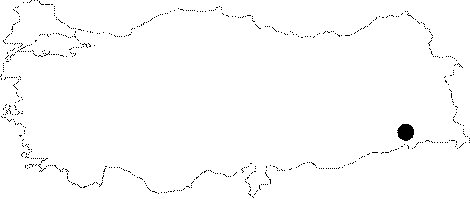|
©The Archaeological Settlements of Turkey - TAY Project
|
|
|
|
|
|
Ber Ava Sikefte |
|
|
For site maps and drawings please click on the picture...  |
For photographs please click on the photo...  |
|
Type:
|
Rock Shelter and Artifact Scatter |
|
Altitude:
|
1000 m |
|
Region:
|
Southeastern Anatolia |
|
Province:
|
Siirt |
|
District:
|
Eruh |
|
Village:
|
|
|
Investigation Method:
|
Survey |
|
Period:
|
Aceramic |
|
|
|
 |
|
| Location: This site is located southeast of the city of Siirt; north of the Siirt-Sirnak highway; and 58.9 km from Siirt via this highway. The exact location of the site has not been represented on a map. The site must be between 3.5 and 4 km southeast of the town of Eruh since the distance between this town and Siirt is 54 km. It is assumed that the site lies very close to the highway. The site is similarly not represented on the map accompanying Benedict's site report. The survey code of this site is T 65 / 1. |
| Geography and Environment: This site is a rock-shelter-site located along the western flanks of Mount Yalnizca. Obsidian and flint chipped stone tools can be found on the terrace by the entrance of the rock shelter and in the agricultural fields beneath this terrace. The area with chipped stone tools is 90x60 m in size. The height of the terrace; where chipped stone tools can be found; above the field is 20 m. The topography of the region is comprised of low plains and mountain chains. |
| History: |
| Research and Excavation: The site was discovered in 1963 during the survey conducted in the Diyarbakir-Sanliurfa and Siirt Provinces to determine the sites in a transitional phase between intensive hunting and gathering to food production. The rock shelter; which is visible from the highway going to Sirnak from Siirt; must have prompted the researcher to survey the area and thus to discover this open-air artifact scatter and rock shelter site. |
| Stratigraphy: The stratigraphy has not been determined because no excavation was conducted on the fields or in the rock shelter. There must have been an Aceramic Neolithic settlement at the site because all the ceramics found dated to a "late period" and the chipped stone recovered was characteristically Neolithic. |
| Small Finds: Chipped Stone: Most of the chipped stone surface finds were flint while a few obsidian artifacts were also collected. The obsidian tools include cores and core revival plates. The blades appear to have been carefully knapped and lack retouching. Crescents; triangles; trapezoidal geometric tools have also been found. Flakes constitute 40% of the obsidian assemblage found. The scrapers appear to have been well-worn. Especially flint scrapers have been knapped with care. The area yielded a total of 976 chipped stone tools and other fragments. The most common tools are convex end scrapers on blades and rounded scrapers on flakes but pyramidal cores were also found. |
| Remains: |
| Interpretation and Dating: Balkan-Atli assigned the chipped stone tools from this site to the Neolithic Period [Balkan-Atli 1994:100-101]. No grinding stones were found. |